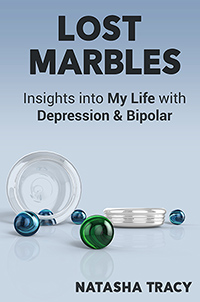What Types of Therapies are Taught to People with Bipolar at Treatment Centers Plus More

Today’s article is another in the series on inpatient treatment facilities. These questions have been answered by the staff at Timberline Knolls – the Bipolar Burble blog’s new sponsor. These questions were submitted by readers and cover bipolar treatments, length of stay, mental illness life skills, and use of discipline.
What types of treatment do you use? Is art therapy available?
The evidence based treatment for bipolar disorder are mood stabilizing medications, DBT [dialectical behavior therapy], CBT [cognitive behavioral therapy], and learning coping skills to help identify the triggers that are happening when someone becomes more depressed or manic in the cycle of emotions. Yes, art therapy is available a few times per week at Timberline Knolls, and we encourage our residents to use art to express their emotions.
Is there an emphasis on group therapy and if so, why?
Yes, the Timberline Knolls program is very intensified in the use of group therapy. We have specific groups related to mood specific disorders such as Stages of Recovery for Mood Disorders, DBT Classes, Stress Management, ect[sic]. Groups are a vital part of our program because it helps residents understand that they are not alone in this recovery process and that others in their group have experienced very similar situation, feelings and reactions to having bipolar disorder. They can also feel very supported by their peers in group therapy.
What techniques are taught to individuals to achieve the highest quality of life?
DBT skills are very useful skills to learn when dealing with active symptoms from bipolar disorder. One word, “structure” is very important in a bipolar person’s life. Without structure it seem as though it is difficult for many to maintain a healthy quality of life. Use of Mindfulness is important and Opposite to Emotion Action Skills. Also, learning how to use ACT (Acceptance Commitment Therapy), particularly defusing techniques. Many times resident have racing thoughts that they fuse with. We try and teach residents that you don’t have to act on those thoughts and that it is important to commit to defusing from those thoughts. You don’t have to do what your thoughts are always telling you. Specifically when the thoughts are self-destructive. They are just thoughts.
How structured are you? Is there an enforced bed time or mandatory morning goals meetings, etc.? What is the food like? Does the staff eat there?
Timberline Knolls’ program is extremely structured. Most residents need the structure in order for them to get their lives back into recovery. There are regular bed times and wake up times, which helps the residents bio-rhythms get back in a normal range. We use the ADA [American Diabetes Association] food plan and it is a very balance meal plan. If residents have diagnosis they may sit at a meal support table and have staff eating with them.
How long does one stay at a residential treatment center? What is the average? Is there a maximum or minimum amount of time? How is discharge determined?
The average length of stay is anywhere from 45 to 60 days. Usually we recommend at the very least 30 days. As we assess residents active symptoms we determine how long this level of care may be needed knowing that some type of OP [outpatient] plan at discharge will always be recommended.
Is there a system of discipline involved in everyday living activities? Are privileges taken away under certain circumstances? What are those circumstances?
At Timberline Knolls we really don’t use a punishment system. Residents move through 3 Phases of recovery, “Coming In”, “Looking In”, “Looking Out.” Only for safety reasons or if a resident becomes more active in their symptoms would we move a resident back to another phase of recovery to provide them with the extra support they would need.
By limiting a person’s exposure to external environments, do you feel that patients are being kept from accessing effective advocacy and support networks, for instance, child protection services?
At Timberline Knolls we really work hard at building residents support systems. We believe that is it an integral part of their recovery. In the second two phases of recovery residents are able to go out into the community for 12 step meetings and other experiential events to see what it feels like to have more independence.
How much does staying at a residential treatment center cost? What would you say to people who can’t afford residential treatment?
The cost of RTC (residential) level of care can vary depending on size and amount of services provided. If one cannot afford RTC, then I would recommend to build as much structure into your recovery program as possible by going to an OP (outpatient) program, meetings – keeping recovery the highest priority.
These questions were answered by Guy Oberwise, LCSW, Primary Therapist and Mood Disorders Coordinator at Timberline Knolls.
If you have any questions about Timberline Knolls, call them at 877-257-9612.









This article was so nice and informative. I wish that I could participate in a program like this. The therapies sound right in line with what “we” need but can’t quite recreate on our own.
It is sad to me that continued use of mind-based therapy for people whose problems don’t stem from their mind is practiced and supported by institutions. People’s traumas that they carry around are stored in their bodies and do not necessarily come out through their minds or their actions. Their thoughts are based on emotions that we don’t even deal with.